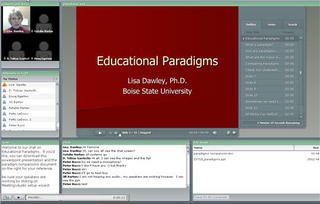
Sssssh! I have a dark secret that I'm about to reveal....up until this point in time, it was not considered socially or professionally appropriate for me to admit one of my great passions. Yes, it's true, I am an online gamer. I've played mmorpg (massive multiplayer online role play games) for years....Asheron's Call, Dark Ages of Camelot, Star Wars Galaxy, and now World of Warcraft for the last two years. It all started 11 years ago when Dr. John Johnston pulled me into a MOO to conduct action research online, and I've never been the same.
I can hear it now...the whispers behind my back...you mean she plays those games that teenage boys play?? Hang onto your hats. The world of educational gaming is starting to bust loose, and come to find out, the population of gamers is a lot bigger than boys from 14-17. I am not alone. This will save me thousands in therapy.
Now, you might be asking yourself, why is she talking about educational gaming in a blog about Online Education? Come on...I know you can see it....the intersect that is being created between the two fields. And that intersect is only going to get bigger as our current generation of kids who've played electronic games their entire lives moves into the adult workplace. If you'd like a little more background on the topic, check out the Horizon Report published by Educause. It looks at trends over the next 5 years and educational gaming is one of them. Bernie Dodge at SDSU has a blog on educational gaming, and a lot of good resources for those interested in reading and learning more about educational gaming and simulations. Heck, even the Federation of American Scientists (FAS) recently held a Summit on Video Gaming.
This fall I've been asked to teach a new graduate course on Educational Gaming and Simulations. I feel as if I've come home. I'll actually be getting paid to better understand and teach others about the aspects and design of gaming for learning purposes.
PS Many of my graduate students have confided to me in email that they are gamers, as well. I'm looking forward to having public discussions on that topic this coming fall.







